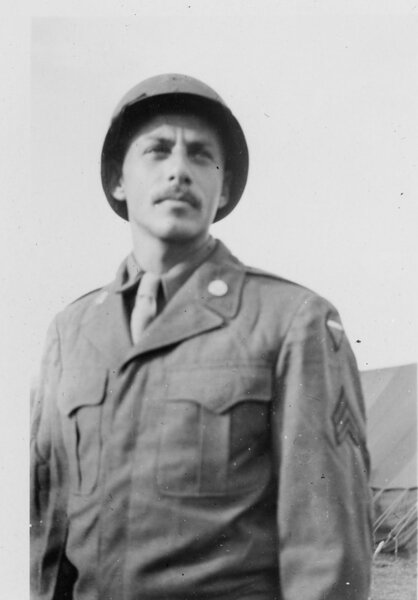Joseph Mack

PFC in 603rd Engineer Camouflage Bn : Co A
ASN#32422833
Born 1921 in NY, Died 2007
Artist
County of residence at enlistment: Queens County, NY
Other residence(s): Huntington Bay, NY in 2002
United States Army, European Theatre of Operations
Occupation before the war: decorators and window dressers
College education before the war: American School of Design 4 years
Joseph Mack was born on August 23, 1921 in New York City, the oldest of three sons. He studied at the art school of Charles H. Woodbury in Ogunquit, ME, where he met Daisy Jean Andrews, the artist who would become his wife. They both earned their degrees from the American School of Design in New York City; Joe was primarily a sculptor and Jean a painter.
Joe registered for the draft on February 15, 1942; at the time he was living in Elmhurst, NY and working for E.B. Meyrowitz Opticians in Manhattan. (Meyrowitz has been (and still is) a luxury eyeglass provider since the 19th century and employs a team of craftspeople who make both the frames and the lenses by hand. Possibly Joe put his sculpture talent to work on eyeglass frames?)
Joe enlisted in the Army on August 6, 1942; at the time his profession was reported as "decorators and window dressers." He and Jean married on March 27, 1943 while Corporal Mack, a member of the 603rd Engineer Camouflage Battalion, was stationed at Fort Meade.
Like many Ghost Army artists, Joe painted the people and places he encountered while stationed in Europe. Several of his watercolors appear in The Ghost Army of World War II. Also in the book is a photograph of his traveling paint case—a dozen colors stashed in a tiny lozenge box. Joe also painted beautiful illustrations on his letters home to Jean, who was living in New Jersey and working as a New York City retail buyer.
After the war, Joe and Jean moved to Woodstock, NY where, according to their son Steve, "they planned to make love and art for the rest of their lives. Since making a living was not part of their plan, they eventually found themselves in the Herald Tribune, looking at jobs for artists."
Steve was born in 1946 and the little family moved to Apple Tree Farm, a small farm in Northport, Long Island, where they worked from the barn. They operated Jean Mack Studio, creating displays for store windows, commercial murals, sculptures, and illustrations.
In 1954, they bought High Lindens, a 22-room Georgian/Italianate mansion on a hilltop in Huntington, NY; it had been built in the 1830s. Around the same time Joe started Joseph Mack Associates, a sales promotion firm in New York that specialized in dimensional design for national advertisers.
In 1971, Joe suffered a life-threatening car accident and retired from his business. Casting about for something else to do, he and Jean took a fresh look at their large home. They installed five sculpture studios in the basement, converted the ballroom to a drawing studio, and opened the Huntington Fine Arts Workshop. They started with 40 students—a mix of adults and children. "It's as close as we could get to a Renaissance atelier," said Joe in a 1980 interview. And Steve Mack says that "in a sense they had returned to their beginnings where they were most happy, living a creative life and passing it along to hundreds of budding young artists. I believe that affecting so many in such a positive way as this was the most satisfying time in his career." By 1978, it had become the Huntington School of Fine Arts, and eventually moved out of their home to its own building in the hamlet of Greenlawn (part of Huntington).
Joe and Jean continued to create their own art while they ran and taught at the school. They held a joint show at Caravan House in New York City in 1972, and Joe's large sculptures could be found at the former World Trade Center in New York and in front of Cornell University, as well as in private collections. Her paintings are in a number of corporate collections.
Jean died in 2001 and Joe in 2007. Steve recalls that at Joe's memorial service, "the family was dwarfed by the outpouring of past and current students from over the previous 30 years."
They are buried at Huntington Rural Cemetery, which can be seen from the windows of their former home.
Sources:
1940 census
1942 draft card
1942 enlistment record
1943 marriage record
1980 article in the New York Times about a zoning challenge for the school
https://timesmachine.nytimes.com/timesmachine/1980/03/16/111773291.html?pageNumber=235
2000 article in New York Times re Huntington School
https://www.nytimes.com/2000/11/26/nyregion/in-fine-arts-and-college-bound.html
2007 Social Security death record
2007 Find a Grave record
https://www.findagrave.com/memorial/234302988/joseph-mack
2014, April 8, email from Stephen Mack to Rick Beyer
History of the house where the Macks lived, and where they first opened the school
https://huntingtonhistory.com/2011/03/02/high-lindens/
Website of the Huntington School